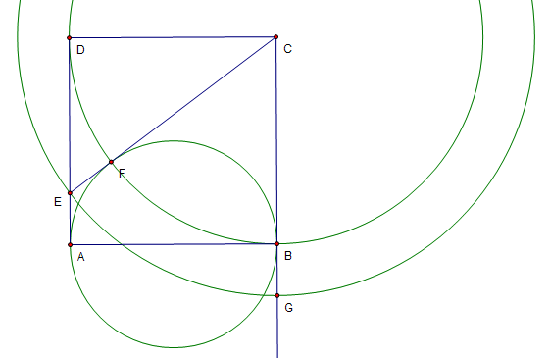Difference between revisions of "2004 AMC 12A Problems/Problem 18"
m (→Solution 2) |
(Solution 5) |
||
| Line 114: | Line 114: | ||
<cmath> \sqrt{4+(2-x)^2} = \sqrt{4+(3/2)^2} = \sqrt{25/4} = \boxed{\frac{5}{2}} </cmath> | <cmath> \sqrt{4+(2-x)^2} = \sqrt{4+(3/2)^2} = \sqrt{25/4} = \boxed{\frac{5}{2}} </cmath> | ||
| − | == | + | ==Solution 5== |
| − | |||
| − | |||
| − | |||
| − | + | <math>\boxed{(D)\frac{5}{2}}</math> | |
| − | {{ | ||
Revision as of 21:49, 20 January 2020
- The following problem is from both the 2004 AMC 12A #18 and 2004 AMC 10A #22, so both problems redirect to this page.
Problem
Square ![]() has side length
has side length ![]() . A semicircle with diameter
. A semicircle with diameter ![]() is constructed inside the square, and the tangent to the semicircle from
is constructed inside the square, and the tangent to the semicircle from ![]() intersects side
intersects side ![]() at
at ![]() . What is the length of
. What is the length of ![]() ?
?
![[asy] size(100); defaultpen(fontsize(10)); pair A=(0,0), B=(2,0), C=(2,2), D=(0,2), E=(0,1/2); draw(A--B--C--D--cycle);draw(C--E); draw(Arc((1,0),1,0,180)); label("$A$",A,(-1,-1)); label("$B$",B,( 1,-1)); label("$C$",C,( 1, 1)); label("$D$",D,(-1, 1)); label("$E$",E,(-1, 0)); [/asy]](http://latex.artofproblemsolving.com/d/a/e/daef6f3ebe3e1fc6cfacd8611db1d6d449c8d2d4.png)
![]()
Solution 1
![[asy] size(150); defaultpen(fontsize(10)); pair A=(0,0), B=(2,0), C=(2,2), D=(0,2), E=(0,1/2), F=E+(C-E)/abs(C-E)/2; draw(A--B--C--D--cycle);draw(C--E); draw(Arc((1,0),1,0,180));draw((A+B)/2--F); label("$A$",A,(-1,-1)); label("$B$",B,( 1,-1)); label("$C$",C,( 1, 1)); label("$D$",D,(-1, 1)); label("$E$",E,(-1, 0)); label("$F$",F,( 0, 1)); label("$x$",(A+E)/2,(-1, 0)); label("$x$",(E+F)/2,( 0, 1)); label("$2$",(F+C)/2,( 0, 1)); label("$2$",(D+C)/2,( 0, 1)); label("$2$",(B+C)/2,( 1, 0)); label("$2-x$",(D+E)/2,(-1, 0)); [/asy]](http://latex.artofproblemsolving.com/4/8/2/4820e9c378ef42e0fe36c7d37d2bb816d542a300.png) Let the point of tangency be
Let the point of tangency be ![]() . By the Two Tangent Theorem
. By the Two Tangent Theorem ![]() and
and ![]() . Thus
. Thus ![]() . The Pythagorean Theorem on
. The Pythagorean Theorem on ![]() yields
yields

Hence ![]() .
.
Solution 2
Call the point of tangency point ![]() and the midpoint of
and the midpoint of ![]() as
as ![]() .
. ![]() by Tangent Theorem. Notice that
by Tangent Theorem. Notice that ![]() . Thus,
. Thus, ![]() and
and ![]() . Solving
. Solving ![]() . Adding, the answer is
. Adding, the answer is ![]() .
.
Solution 3
Clearly, ![]() . Thus, the sides of right triangle
. Thus, the sides of right triangle ![]() are in arithmetic progression. Thus it is similar to the triangle
are in arithmetic progression. Thus it is similar to the triangle ![]() and since
and since ![]() ,
, ![]() .
.
Solution 4
![[asy] size(150); defaultpen(fontsize(10)); pair A=(0,0), B=(2,0), C=(2,2), D=(0,2), E=(0,1/2), F=E+(C-E)/abs(C-E)/2, G=(1,0); draw(A--B--C--D--cycle);draw(C--E); draw(Arc((1,0),1,0,180));draw((A+B)/2--F); label("$A$",A,(-1,-1)); label("$B$",B,( 1,-1)); label("$C$",C,( 1, 1)); label("$D$",D,(-1, 1)); label("$E$",E,(-1, 0)); label("$F$",F,( 0, 1)); label("$x$",(A+E)/2,(-1, 0)); label("$x$",(E+F)/2,( 0, 1)); label("$2$",(F+C)/2,( 0, 1)); label("$2$",(D+C)/2,( 0, 1)); label("$2$",(B+C)/2,( 1, 0)); label("$2-x$",(D+E)/2,(-1, 0)); label("$G$",G,(0,-1)); dot(G); draw(G--C); label("$\sqrt{5}$",(G+C)/2,(-1,0)); [/asy]](http://latex.artofproblemsolving.com/a/9/4/a945dc4c5d8e4d141e7fedc0828d0c0dbb79d5cc.png)
Let us call the midpoint of side ![]() , point
, point ![]() . Since the semicircle has radius 1, we can do the Pythagorean theorem on sides
. Since the semicircle has radius 1, we can do the Pythagorean theorem on sides ![]() . We get
. We get ![]() . We then know that
. We then know that ![]() by Pythagorean theorem. Then by connecting
by Pythagorean theorem. Then by connecting ![]() , we get similar triangles
, we get similar triangles ![]() and
and ![]() . Solving the ratios, we get
. Solving the ratios, we get ![]() , so the answer is
, so the answer is ![]() .
.
Solution 5
Using the diagram as drawn in Solution 5, let the total area of square ![]() be divided into the triangles
be divided into the triangles ![]() ,
, ![]() ,
, ![]() , and
, and ![]() . Let x be the length of AE. Thus, the area of each triangle can be determined as follows:
. Let x be the length of AE. Thus, the area of each triangle can be determined as follows:
![]()
![]()
![]()
![]() (the length of CE is calculated with the Pythagorean Theorem, lines GE and
CE are perpendicular by definition of tangent)
(the length of CE is calculated with the Pythagorean Theorem, lines GE and
CE are perpendicular by definition of tangent)
Adding up the areas and equating to the area of the total square (2*2=4), we get
![]()
Solving for x:
![]()
![]()
![]()
![]()
Solving for length of CE with the value we have for x:
![]()
Solution 5
![]()










